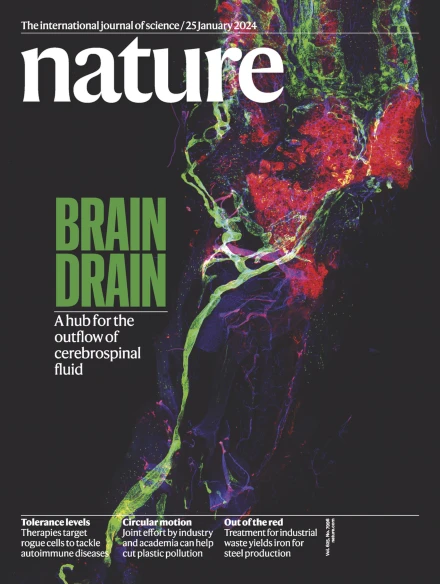Ru and W isotope systematics in ocean island basalts reveals core leakage
IF 50.5
1区 综合性期刊
Q1 MULTIDISCIPLINARY SCIENCES
引用次数: 0
Abstract
The isotopic composition of lavas associated with mantle plumes has previously been interpreted in the light of core–mantle interaction, suggesting that mantle plumes may transport core material to Earth’s surface1–5. However, a definitive fingerprint of Earth’s core in the mantle remains unconfirmed. Precious metals, such as ruthenium (Ru), are highly concentrated in the metallic core but extremely depleted in the silicate mantle. Recently discovered mass-independent Ru isotope variations (ε100Ru) in ancient rocks show that the Ru isotope composition of accreted material changed during later stages of Earth’s growth6, indicating that the core and mantle must have different Ru isotope compositions. This illustrates the potential of Ru isotopes as a new tracer for core–mantle interaction. Here we report Ru isotope anomalies for ocean island basalts. Basalts from Hawaii have higher ε100Ru than the ambient mantle. Combined with unradiogenic tungsten (W) isotope ratios, this is diagnostic of a core contribution to their mantle sources. The combined Ru and W isotope systematics of Hawaiian basalts are best explained by simple core entrainment but addition of core-derived oxide minerals at the core–mantle boundary is a possibility. Ru isotopes are proposed as tracers for core–mantle interaction on Earth, and anomalies for ocean island basalts from Hawaii are reported that have higher ε100Ru than the ambient mantle.

洋岛玄武岩Ru、W同位素系统揭示岩心渗漏
与地幔柱相关的熔岩的同位素组成先前已经根据核-地幔相互作用进行了解释,表明地幔柱可能将核心物质运送到地球表面1,2,3,4,5。然而,地核在地幔中的确切指纹仍未得到证实。贵重金属,如钌(Ru),高度集中在金属地核中,但在硅酸盐地幔中极度枯竭。最近在古岩石中发现的与质量无关的Ru同位素变化(ε100Ru)表明,在地球生长的后期,吸积物质的Ru同位素组成发生了变化6,表明地核和地幔的Ru同位素组成一定不同。这说明了钌同位素作为核幔相互作用的新示踪剂的潜力。本文报道了洋岛玄武岩的钌同位素异常。夏威夷玄武岩的ε100Ru高于周围地幔。结合非放射性成因的钨(W)同位素比值,可以诊断出地核对地幔源的贡献。夏威夷玄武岩的Ru和W同位素组合系统最好的解释是简单的岩心夹带作用,但在岩心-地幔边界添加岩心衍生的氧化矿物是可能的。
本文章由计算机程序翻译,如有差异,请以英文原文为准。
求助全文
约1分钟内获得全文
求助全文
来源期刊

Nature
综合性期刊-综合性期刊
CiteScore
90.00
自引率
1.20%
发文量
3652
审稿时长
3 months
期刊介绍:
Nature is a prestigious international journal that publishes peer-reviewed research in various scientific and technological fields. The selection of articles is based on criteria such as originality, importance, interdisciplinary relevance, timeliness, accessibility, elegance, and surprising conclusions. In addition to showcasing significant scientific advances, Nature delivers rapid, authoritative, insightful news, and interpretation of current and upcoming trends impacting science, scientists, and the broader public. The journal serves a dual purpose: firstly, to promptly share noteworthy scientific advances and foster discussions among scientists, and secondly, to ensure the swift dissemination of scientific results globally, emphasizing their significance for knowledge, culture, and daily life.
 求助内容:
求助内容: 应助结果提醒方式:
应助结果提醒方式:


